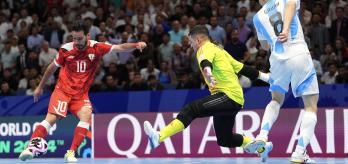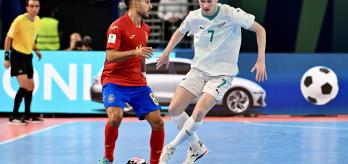Throughout the game against New Zealand, Spain proved their superiority in possession by being patient on the ball despite going behind early in the first period. Federico Vidal’s team stuck with the game plan across both periods and reaped the rewards in the second following a hat-trick from Player of the Match, Catela, who put his side top of Group D. Below, Technical Study Group member Carlos Quiros delves deeper into Spain’s game plan and the tactical system and technical mastery that underpinned it.
The BROADER TACTICAL SYSTEM
Quiros, who observed the game at the Andijan Universal Sports Complex, noted that Spain’s 4-0 system has been “perfected”, and has benefits offensively and defensively:
“Vidal’s team are excellent in possession which limits the opponent’s chances of scoring. The Spanish style of play gives the players at this World Cup a great deal of passing and offensive movement, and it is no coincidence that they have perfected the 4-0 system for the rest of the world,” explained Quiros.
Spain’s system dominated during both periods, despite some possible frustration for La Roja following Art Twigg’s goal, which gave New Zealand the lead in the sixth minute of play. Spain’s opponents registered merely 10 attempts at goal throughout the entire match, recording two on target.
Safe possession
Quiros also highlighted the importance of Spain’s technical executions coinciding with their overarching objective of retaining possession to ensure control of the game. Every technical action and movements to receive the ball are taken with careful consideration and in alignment with the team’s tactical strategy. He noted, "The passes are well weighted and accurate, the dribbling of the ball is effective, the controls are oriented safely, players are always observing the available spaces, and there are constant movements from the team-mates without the ball looking for the best position.”
One key data point that corresponds with this analysis is how few long balls were played by Vidal’s side during the match. According to FIFA’s Futsal Language Terminology, a pass is classified as a “long ball” if it travels forwards more than two zones to reach its recipient (e.g. from zone 1 to zones 3 or 4; or zone 2 to zone 4). Throughout the FIFA Futsal World Cup 2024™ thus far, there has been an average of 25 long balls per team per match over the 24 fixtures, whereas La Roja played only six in their victory over New Zealand.
In contrast, New Zealand have averaged 38 long balls per game in this tournament. These types of distributions are more difficult to execute – both for the player passing the ball and the one receiving it – and can lead to easy turnovers in possession. Teams like Spain, who want to retain the ball, opt to have fate in their own hands with accurate short and mid-ranged passes, effective dribbling and good positioning of the body to receive and play. FIFA’s “receptions retained” metric backs this tendency. Against New Zealand, after receiving passes La Roja players successfully retained the ball with their next action 737 times. This is the highest figure registered by any performance in the tournament so far.
Nevertheless, scoring goals is the ultimate objective for Spain. They are dedicated to patience during the attacking phase, waiting for the opportune moment to score and capitalise on their dominance. Frequently, this entails initiating the attacking phase through a “crossing line” action, which is when a player dribbles with the ball over the halfway line and passes to a team-mate. Clip 2 below showcases Spain using a crossing line action to initiate an attacking phase which leads to a goal. Antonio Pérez (2) carries the ball over the line before playing a one-two with Francisco Cortés (7) which eventually leads to the finish from Catela (3).
TECHNICAL DOMINANCE & SPACIAL AWARENESS
Quiros continued to stress the importance of Spain’s technical actions in executing their game-plan, diving into more specific detail of how Vidal’s team managed to wear down their opponents using rotations and offensive movements.
“Spain are undoubtedly an example of how to train young players in the adequate occupation of spaces, movements, rotations and positional play between defensive lines. The decision-making of the Spanish game is based on its immediate change of roles and functions, the useful possession of the ball and the alternation of its offensive movements,” Quiros explained.
While analysing Spain’s keenness to hold possession as their attacking strategy and deny possession as their defensive objective, dominance of the ball is not possible without well-polished technical skills and rotations.
It is with these skills, intertwined with the collective tactical strategy of keeping possession, that La Roja truly dominated the game. By the end of the game against New Zealand, they had completed 681 of their 731 total passes. This a completion rate of 93.2%, which is one of the highest pass-completion rates in the tournament so far and 10% higher than the average rate registered by teams in the first 20 games.
ABILITY TO EXECUTE
Comparison with first game
The final observation made by Quiros was Spain’s efficiency in front of goal. Here he compared their emphatic victory over New Zealand with their first match of the group phase against Kazakhstan, which ended in a 1-1 draw. The former Costa Rica head coach revealed that the main difference between the two matches, despite having plenty of goalscoring opportunities in both, was how effective Vidal’s side were in possession.
“In the two games played by Spain, their main offensive characteristic was the number of shots on goal. In their first game, if it was not for the opposition’s goalkeeper, Higuita, the score would have been different. In the second game, the big difference in the score had to do with the effective possession of the Spanish attack, their offensive movements and their great ability to finish against the goalkeeper and the rival defence,” Quiros stated.
Persistence paying off
Spain benefitted greatly from persisting with their game plan, despite drawing 1-1 at the break. La Roja continued with this effective possession that Quiros mentioned in both periods and this faith prospered after the interval.
In fact, Spain had more attempts on goal in the first period (57) than in the second period (51) but scored six goals in the latter compared to just one in the former. An increased potency in front of goal was a primary reason for this: 37.3% of Spain’s attempts in the second period were on target compared to 29.8% of their attempts being on target in the first.
In Clip 3 below, Spain build play with their goalkeeper who rolls the ball to Cortés (7). Cortés plays a simple pass to Tomaz Braga (4), who slips a sublime first-time ball into Catela (3). Catela has the ideal body position to receive on his left foot before cutting inside, beating his man with an excellent piece of dribbling and firing past the New Zealand goalkeeper at the near post to earn his hat-trick.
KEY INSIGHTS
-
The technique of individual players is intertwined with the team’s overarching tactical system. In order perfect a game plan based on possession, players require a certain level of technical ability.
-
Persistence with a game-plan can lead to success on the court, even if these rewards are not apparent straight away. Despite drawing at half-time, Spain continued with their strategy and did not opt for longer passes or rushed opportunities.
-
Playing a possession-oriented game does not mean that movement must be static when players have the ball. Patience, rotations, occupying space between the lines, decision-making, and the changing of roles and functions are all of the utmost importance to play in this manner.























